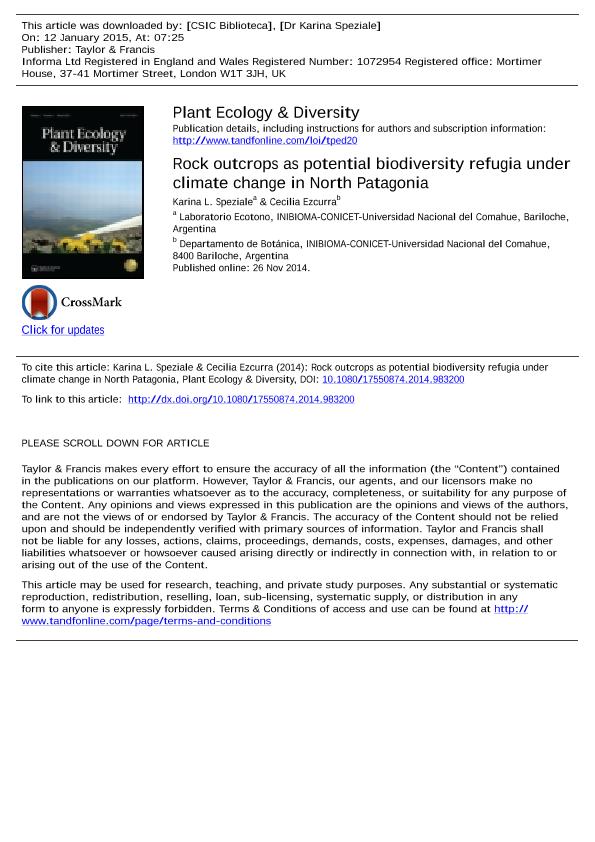Mostrar el registro sencillo del ítem
dc.contributor.author
Speziale, Karina Lilian

dc.contributor.author
Ezcurra, Cecilia

dc.date.available
2017-01-25T19:23:03Z
dc.date.issued
2015-05
dc.identifier.citation
Speziale, Karina Lilian; Ezcurra, Cecilia; Rock outcrops as potential biodiversity refugia under climate change in North Patagonia; Taylor & Francis; Plant Ecology & Diversity; 8; 3; 5-2015; 353-361
dc.identifier.issn
1755-0874
dc.identifier.uri
http://hdl.handle.net/11336/11910
dc.description.abstract
Background: Under climate-change scenarios, rock outcrops, by providing microclimatically diverse habitats, different from those of surrounding zonal vegetation matrix, may serve as climatic refugia and thereby facilitate the persistence of specialist species. Aim: We tested whether rock outcrops of southern temperate latitudes could act as local refugia for a cold-adapted flora in the face of global warming. Methods: We related species composition of 50 outcrops and that of their surrounding vegetation to climatic data at local and regional scales to establish whether species distributions reflected differences that could indicate the existence of climatic refugia. Results: While at a regional scale, species composition of the outcrops across the study area was related to mean annual precipitation and mean annual maximum temperature, locally, southern faces of outcrops had different species and lower maximum temperatures than insolated north faces and surrounding vegetation plots. Conclusions: South faces of outcrops by providing cool microhabitats, and currently harbouring species not found in the surrounding zonal vegetation matrix, could serve as local refugia for heat-intolerant plants and other microthermic organism. The degree of ‘stability’ of these refugia will depend on the degree of future change in climate. Therefore, it is important to plan protected area networks that maximise local environmental heterogeneity, including the protection of rock outcrops both as refugia for cold-adapted species and as potential stepping stones that would allow dispersal of these species between supportive environments through unfavourable ones.
dc.format
application/pdf
dc.language.iso
eng
dc.publisher
Taylor & Francis

dc.rights
info:eu-repo/semantics/openAccess
dc.rights.uri
https://creativecommons.org/licenses/by-nc-sa/2.5/ar/
dc.subject
CLIMATE CHANGE
dc.subject
MICROCLIMATE
dc.subject
REFUGIA
dc.subject
ROCK OUTCROPS
dc.subject
SPECIES COMPOSITION
dc.subject.classification
Ecología

dc.subject.classification
Ciencias Biológicas

dc.subject.classification
CIENCIAS NATURALES Y EXACTAS

dc.title
Rock outcrops as potential biodiversity refugia under climate change in North Patagonia
dc.type
info:eu-repo/semantics/article
dc.type
info:ar-repo/semantics/artículo
dc.type
info:eu-repo/semantics/publishedVersion
dc.date.updated
2016-12-12T14:21:56Z
dc.journal.volume
8
dc.journal.number
3
dc.journal.pagination
353-361
dc.journal.pais
Reino Unido

dc.journal.ciudad
Londres
dc.description.fil
Fil: Speziale, Karina Lilian. Consejo Nacional de Investigaciones Científicas y Técnicas. Centro Científico Tecnológico Conicet - Patagonia Norte. Instituto de Investigaciones en Biodiversidad y Medioambiente. Universidad Nacional del Comahue. Centro Regional Universidad Bariloche. Instituto de Investigaciones en Biodiversidad y Medioambiente; Argentina
dc.description.fil
Fil: Ezcurra, Cecilia. Consejo Nacional de Investigaciones Científicas y Técnicas. Centro Científico Tecnológico Conicet - Patagonia Norte. Instituto de Investigaciones en Biodiversidad y Medioambiente. Universidad Nacional del Comahue. Centro Regional Universidad Bariloche. Instituto de Investigaciones en Biodiversidad y Medioambiente; Argentina
dc.journal.title
Plant Ecology & Diversity

dc.relation.alternativeid
info:eu-repo/semantics/altIdentifier/url/http://www.tandfonline.com/doi/abs/10.1080/17550874.2014.983200?journalCode=tped20
dc.relation.alternativeid
info:eu-repo/semantics/altIdentifier/doi/http://dx.doi.org/10.1080/17550874.2014.983200
Archivos asociados
